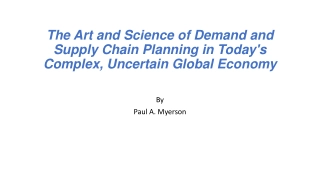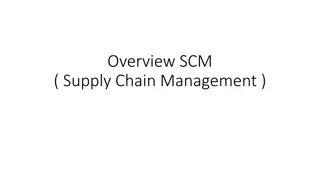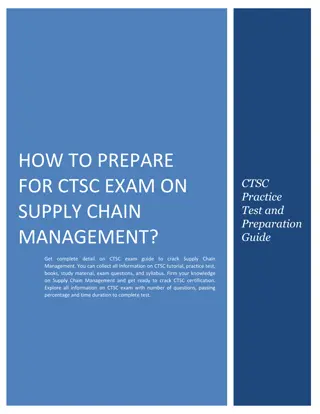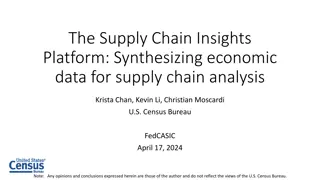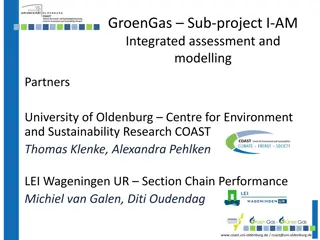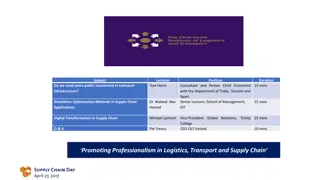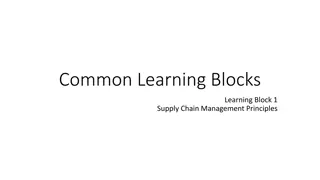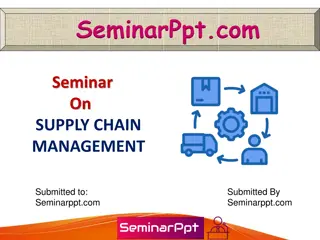
Managing Uncertainty in Supply Chain with Safety Inventory
Explore the role of safety inventory in managing uncertainty in a supply chain at Northern Illinois University. Understand how safety inventory helps account for demand uncertainty and optimizes product availability while balancing inventory holding costs. Learn about determining appropriate safety inventory levels and making trade-offs for profit optimization in supply chain management.
Download Presentation

Please find below an Image/Link to download the presentation.
The content on the website is provided AS IS for your information and personal use only. It may not be sold, licensed, or shared on other websites without obtaining consent from the author. If you encounter any issues during the download, it is possible that the publisher has removed the file from their server.
You are allowed to download the files provided on this website for personal or commercial use, subject to the condition that they are used lawfully. All files are the property of their respective owners.
The content on the website is provided AS IS for your information and personal use only. It may not be sold, licensed, or shared on other websites without obtaining consent from the author.
E N D
Presentation Transcript
NIU Value of Component Commonality in Managing Uncertainty in a Supply Chain Northern Illinois University Department of Technology Shun Takai
Role of Safety Inventory in a Supply Chain
Role of Safety Inventory in a Supply Chain If demand is certain: Daily demand is constant We know how long it will take to consume all inventory to satisfy the demand Illustration D=20 (Daily demand) Q=100 (Replenishment lot size) L=5 (Lead time for inventory replenishment) 100 Replenishment lot size(Q) 50 Inventory Cycle inventory 0 0 5 10 15 20 -50 Replenishment lot arrives Time
Role of Safety Inventory in a Supply Chain If demand is uncertain: Demand may be larger or smaller than the average If the demand is large than the average, all inventory may be consumed before next replenishment lot arrives Illustration D=20 (Average daily demand) Q=100 (Replenishment lot size) L=5 (Lead time for inventory replenishment) 100 Small demand Average demand 50 Inventory Large demand 0 0 5 10 15 20 -50 All inventory is consumed before replenishment lot arrives Time
Role of Safety Inventory in a Supply Chain Safety inventory is used to account for uncertainty that: Demand may be larger than the average (or forecasted) Illustration D=20 (Average daily demand) Q=100 (Replenishment lot size) L=5 (Lead time for inventory replenishment) ss=50 (Safety inventory) 150 100 Inventory Cycle inventory 50 Safety inventory to account for demand uncertainty 0 Time 0 5 10 15 20
Determining Appropriate Level of Safety Inventory
Trade-Off in Safety Inventory Decisions Large amount of safety inventory Increases product availability (reduces product shortage); thus increases profit Increases inventory holding costs; thus reduces profit Key questions in safety inventory decisions are: 1. What is the appropriate level of safety inventory? 2. What actions to take to reduce safety inventory while maintaining product availability? (Reference) Supply Chain Management: Strategy, Planning, and Operation. Sunil Chopra and Peter Meindl. (2013) 5th Edition. Boston, MA: Pearson Prentice-Hall.
Determining Appropriate Level of Safety Inventory Safety inventory is determined by: Demand and supply uncertainties Product availability If uncertainty of demand or supply increases: Safety inventory increases If product availability increases: Safety inventory increases (Reference) Supply Chain Management: Strategy, Planning, and Operation. Sunil Chopra and Peter Meindl. (2013) 5th Edition. Boston, MA: Pearson Prentice-Hall.
Measuring Demand Uncertainty Demand in each period (e.g., daily or weekly demand) is modeled by: Di: average demand per period i: standard deviation of demand per period (e.g., forecast error) i = 1, 2, 3, , L Notation is simplified if uncertainty of demand in each period is identical D: average demand per period D: standard deviation of demand per period Lead time is the time between when an order is placed and when the order is received L: lead time (Reference) Supply Chain Management: Strategy, Planning, and Operation. Sunil Chopra and Peter Meindl. (2013) 5th Edition. Boston, MA: Pearson Prentice-Hall.
Measuring Demand Uncertainty Suppose demand in each period is: Independent with one another Normally distributed with: Mean Di and Standard deviation i i = 1, 2, 3, , L Total demand during the lead time of L periods is normally distributed with mean ?? and standard deviation ?? ? ??= ?1+ ?2+ ?3+ + ??= ?? ?=1 (?1)2+(?2)2+(?3)2+ + (??)2 ??= 1 ? ?? ?????? ?? ??????????? (Reference) Supply Chain Management: Strategy, Planning, and Operation. Sunil Chopra and Peter Meindl. (2013) 5th Edition. Boston, MA: Pearson Prentice-Hall.
Measuring Demand Uncertainty If mean and standard deviation of demand during each of L periods are the same: Mean Di = D Standard deviation i = D i = 1, 2, 3, , L Then, the total demand during the lead time of L periods is: Normally distributed with: Mean DL Standard deviation L L terms ??= ? + ? + ? + + ? = ?? (??)2+(??)2+(??)2+ + (??)2= ?(??)2= ??= ??? (2) L terms (Reference) Supply Chain Management: Strategy, Planning, and Operation. Sunil Chopra and Peter Meindl. (2013) 5th Edition. Boston, MA: Pearson Prentice-Hall.
Product Availability and Replenishment Policy
Product Availability and Replenishment Policy Product availability Ability to satisfy customer order from inventory A stockout occurs when: Customer order is not satisfied due to no inventory Example: cycle service level (CSL) Proportion of replenishment cycles that end without stockout Replenishment cycle is the interval between the arrival of two successive replenishment lots Equivalent to probability of replenishment cycle without stockout Replenishment policy consists of: Timing of reorder Quantity of reorder Example: continuous review policy Inventory is continuously monitored Lot size Q is ordered when the inventory reaches the reorder point (ROP) Lot size is same Time between order may change (Reference) Supply Chain Management: Strategy, Planning, and Operation. Sunil Chopra and Peter Meindl. (2013) 5th Edition. Boston, MA: Pearson Prentice-Hall.
Evaluating CSL Given a Replenishment Policy Continuous review replenishment policy is assumed Q: reorder lot size L: replenishment lead time (number of weeks) Weekly demand Normally distributed with: Mean D and Standard deviation D Two cases are discussed next Safety inventory given a replenishment policy CSL given a replenishment policy (Reference) Supply Chain Management: Strategy, Planning, and Operation. Sunil Chopra and Peter Meindl. (2013) 5th Edition. Boston, MA: Pearson Prentice-Hall.
Safety Inventory Given a Replenishment Policy 150 Continuous review replenishment policy When the amount of inventory reaches ROP, a new replenishment order is placed Lead time L 100 Inventory ROP LD 50 From Equation (2) Lot is ordered Safety inventory Lotarrives 0 Time 0 5 10 15 20 ???????? ?????? ?????? ???? ???? = ?? On average, LD products are sold between when the inventory reaches ROP and when the new replenishment lot arrives Thus, the inventory when the replenishment lot arrives is: ??? ?? Thus, safety inventory ss is: ?????? ????????? ?? = ??? ?? (4) (Reference) Supply Chain Management: Strategy, Planning, and Operation. Sunil Chopra and Peter Meindl. (2013) 5th Edition. Boston, MA: Pearson Prentice-Hall.
CSL Given a Replenishment Policy Recall that CSL is equivalent to the probability of replenishment cycle without stockout Stockout does not occur as far as the demand during replenishment lead time L is smaller than ROP; Thus ??? = ???? ?????? ?????? ???? ???? ?? ? ??????? ?? ? ????? ??? If the total demand during the L periods is: Normally distributed with mean DL and standard deviation L CSL can be written as: ??? = ? ???,??,?? = ???????? ???,??,??,1 (5) Excel function ( NORM.DIST instead of NORMDIST is used in Excel 2010) If weekly demand is independent and identically distributed, then from Equation (2), ??and ?? in Equation (5) are: ??= ?? ??= ??? (Reference) Supply Chain Management: Strategy, Planning, and Operation. Sunil Chopra and Peter Meindl. (2013) 5th Edition. Boston, MA: Pearson Prentice-Hall.
Safety Inventory Given Desired CSL Companies often choose replenishment policies to achieve desired levels of product availability Thus, appropriate level of safety inventory needs to be calculated to achieve the desired level of product availability (e.g., in terms of CSL) Next Safety inventory given desired CSL is discussed (Reference) Supply Chain Management: Strategy, Planning, and Operation. Sunil Chopra and Peter Meindl. (2013) 5th Edition. Boston, MA: Pearson Prentice-Hall.
Safety Inventory Given Desired CSL Goal For continuous review replenishment policy, Calculate appropriate safety inventory that achieves the desired CSL Assumption L: lead time CSL: desired cycle service level DL: mean demand during lead time L: standard deviation of demand during lead time (Reference) Supply Chain Management: Strategy, Planning, and Operation. Sunil Chopra and Peter Meindl. (2013) 5th Edition. Boston, MA: Pearson Prentice-Hall.
Safety Inventory Given Desired CSL From Equation (4), ROP=DL+ss Thus, safety inventory ss needs to satisfy the following condition ???? ?????? ?????? ???? ???? ?? ? ??????? ??+ ?? = ??? Given that demand is normally distributed, the above condition can be written as below using cumulative distribution function F() ? ??+ ??,??,?? = ??? Using inverse normal distribution F-1(), ??+ ?? = ? 1???,??,?? ?? = ? 1???,??,?? ?? Using inverse standard normal distribution FS-1(), ?? = ?? 1??? ??= ???????? ??? ??= ???????? ??? ??? (6) Excel function ( NORM.S.INV instead of NORMSINV is used in Excel 2010) (Reference) Supply Chain Management: Strategy, Planning, and Operation. Sunil Chopra and Peter Meindl. (2013) 5th Edition. Boston, MA: Pearson Prentice-Hall.
Impact of Product Design on Safety Inventory Value of Component Commonality
Component Commonality Component commonality is a key to increasing product variety without reducing product availability or without increasing component inventory too much If product variety in a supply chain is large, the variety and amount of components in the supply chain can be significantly large Use of common components in multiple products enables a company to: Aggregate component demand and Reduce component inventory If a distinct component is used in each product: Demand for the component is the same as demand for the finished product in which the component is used If the same component is used in multiple products: Demand for the component is the same as the aggregate demand of all the finished products in which the component is used (Reference) Supply Chain Management: Strategy, Planning, and Operation. Sunil Chopra and Peter Meindl. (2013) 5th Edition. Boston, MA: Pearson Prentice-Hall.
Postponement Postponement is to delay product differentiation or customization until near the time of product sales Component commonality is the key enabler of product postponement Supply chains with and without postponement are graphically compared below Component A Product A No postponement Component B Product B Component C Product C Demand aggregation Product A With postponement Common component D Product B Product C (Reference) Supply Chain Management: Strategy, Planning, and Operation. Sunil Chopra and Peter Meindl. (2013) 5th Edition. Boston, MA: Pearson Prentice-Hall.
Value of Component Commonality Value of component commonality and postponement comes from: Reduction of safety inventory by demand aggregation Consider the following conditions k: number of products Di: mean weekly demand of product i i = 1, , k i: standard deviation of weekly demand of product i i = 1, , k L: replenishment lead time CSL: cycle service level DL: mean demand during lead time L: standard deviation of demand during lead time H: unit inventory holding cost ?= ? C: product cost per unit h: inventory holding cost per year as a fraction of product cost (Reference) Supply Chain Management: Strategy, Planning, and Operation. Sunil Chopra and Peter Meindl. (2013) 5th Edition. Boston, MA: Pearson Prentice-Hall.
Safety Inventory without Aggregation Step 1: Calculate safety inventory (ss) for each product (and component) ss1, ss2, , ssk Step 2: Add safety inventory (ss) for all products ssTotal = ss1+ss2+ +ssk From Equation (6), safety inventory for each product is: Product 1 (i=1): ??1= ?? 1??? ??1 Product 2 (i=2): ??2= ?? 1??? ??2 Product k (i=k): ???= ?? 1??? ??? Total safety inventory without aggregation ???????= ??1+ ??2+ + ??? = ?? 1??? ??1+ ?? 1??? ??2+ + ?? 1??? ??? Using summation, the above formula can be written as: ???????= ?=1 ?? 1??? ??? ? If ?? 1??? ? is same for all products, this term can be moved out of the summation ???????= ?? 1??? ? ?=1 ?? (Source) Supply Chain Management: Strategy, Planning, and Operation. Sunil Chopra and Peter Meindl. (2013) 5th Edition. Boston, MA: Pearson Prentice-Hall. ? (7)
Safety Inventory with Aggregation Step 1: Calculate standard deviation of aggregated demand CD Calculate variance of aggregate demand var(DC) by adding variance of demand for each product (variance is square of i) Calculate standard deviation of aggregated demand CD by taking square root of variance var(DC) Step 2: Calculate safety inventory of product (and component) with aggregation Standard deviation of aggregated demand Variance of aggregated demand is: ??? ??= ?=1 ?? ? 2= ?1 2 2+ + ?? 2+ ?2 This is when demands are independent Then, standard deviation of aggregated demand CD is: ? = ? 2 = 2+ ?2 2+ + ?? 2 ??? ??= ?=1 ?? ?? ?1 (8) Total safety inventory with aggregation ?????? ????????? ??? ??????????? = ?? 1??? ? ?? ?= ?? 1??? ? 2+ ?2 2+ + ?? 2 ?1 (9) (Source) Supply Chain Management: Strategy, Planning, and Operation. Sunil Chopra and Peter Meindl. (2013) 5th Edition. Boston, MA: Pearson Prentice-Hall.
Reduction in Inventory Holding Cost Reduction of inventory holding cost due to aggregation is: ????????? ?? ????????? ?????? ???? = ??????? ???? ??? ??? ??????????? ?????? ???? ??? ??????????? = ?????? ????????? ??? ??? ??????????? ?????? ????????? ??? ??????????? ???? ????????? ?????? ???? (?? ????????? ?????? ???? ?? ???? ??? ??? ??????????) = {???????? 7 ???????? 9 } ? ? ?? 1??? ? ?? ?? 1??? ? ?? ? = ? ?=1 Because ?? 1??? ? is the common term, this term can be moved out of the parenthesis ? = ?? 1??? ? ? ?? ?? ? ?=1 ? = ?? 1??? ? ? 2+ ?2 2+ + ?? 2 ?? ?1 ?=1 (Source) Supply Chain Management: Strategy, Planning, and Operation. Sunil Chopra and Peter Meindl. (2013) 5th Edition. Boston, MA: Pearson Prentice-Hall.
Question An electric bike company e-Motion designs, makes, and sells three models, EM- 100, EM-200, and EM-300, with the following weekly demand EM-100: average of 10, standard deviation of 4 EM-200: average of 20, standard deviation of 8 EM-300: average of 5, standard deviation of 1 Currently, motor with different nominal output is used in each model EM-100: 250 watt motor EM-200: 500 watt motor EM-300: 350 watt motor Lead time of all these motors are 4 weeks (no standard deviation of lead time) e-Motion operates with continuous review replenishment policy Questions If e-Motion wishes to achieve 99% cycle service level (CSL), (1-1) What is the safety inventory of each motor? If e-Motion decides to use 500 watt motor for all models while achieving 99% CSL, (1-2) What is the safety inventory of the motor? If inventory holding cost of each motor is $60 per unit per year, (1-3) How much inventory holding cost will e-Motion save by using common motor?
Answer (1-1) EM-100: ?? = ???????? 0.99 4 4 = 18.6 EM-200: ?? = ???????? 0.99 4 8 = 37.2 EM-300: ?? = ???????? 0.99 4 1 = 4.7 (1-2) Standard deviation of the aggregate demand ?? 42+ 82+ 12= Aggregate: ?? = ???????? 0.99 4 9 = 41.9 ?= 81 = 9 (1-3) 18.6 + 37.2 + 4.7 41.9 60 = 60.5 41.9 60 = $1116.6


